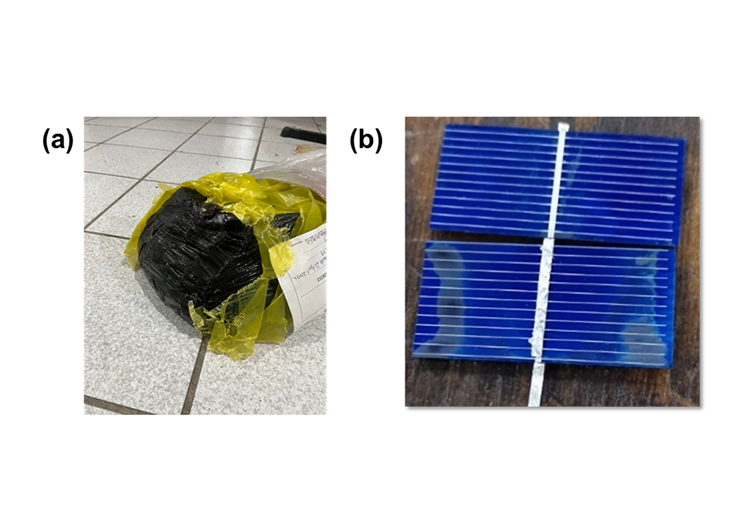Evaluation of HNBR as a substitute polymeric material for encapsulations in silicon photovoltaic panels
DOI:
https://doi.org/10.29312/remexca.v16i30.4054Keywords:
HNBR, rubbers, silicon, solar energy, solar panelsAbstract
Currently, the use of renewable energies, specifically photovoltaic energy, has experienced almost exponential growth due to the increasingly intense energy demand in the world. This has led the photovoltaic industry to focus its efforts on the efficiency of photovoltaic generators. An area of study of great interest is the substitution of materials currently used either as encapsulants or insulators for the manufacture of silicon photovoltaic modules. In this work, polymeric coating tests for photovoltaic cells were carried out using hydrogenated nitrile butadiene rubber to study the feasibility of its use as a photovoltaic encapsulant. Polymer membranes were prepared by pressing under different conditions to obtain the desired optimal adhesion and transparency properties. Finally, tests of electrical variables were performed under standard laboratory conditions (25 °C, 1 000 W m-2, 1.5 air masses). The results of the measurements validate the use of hydrogenated nitrile butadiene as an encapsulating polymer for photovoltaic modules, since this material shows a greater thermal stability of more than 100 °C compared to conventional encapsulants, such as ethylene vinyl acetate, without affecting the passage of electrical current through the material, which makes it a more stable and durable option with potential application in larger-scale solar cells.
Downloads
References
Agroui, K. and Collins, G. 2003. Characterization of EVA encapsulant material by thermally stimulated current technique. Solar Energy Materials and Solar Cells. 80(1):33-45. https://doi.org/10.1016/S0927-0248(03)00112-0.
Agroui, K.; Jaunich, M. and Arab, A. H. 2016. Analysis techniques of polymeric encapsulant materials for photovoltaic modules: situation and perspectives. Energy Procedia. 93:203-210. https://doi.org/10.1016/J.EGYPRO.2016.07.171.
Badiee, A. I.; Ashcroft, I. A. and Wildman, R. D. 2016. The thermo-mechanical degradation of ethylene vinyl acetate is used as a solar panel adhesive and encapsulant. International Journal of Adhesion and Adhesives. 68:212-218. https://doi.org/10.1016/j.ijadhadh.2016.03.008.
Espinosa-Ramírez, B. H. A.; Garrido-Hernández, A.; García-Domínguez, G.; Vargas-León, E. A. and Castillo-Minjarez, J. M. A. 2023. Efecto de la temperatura en la eficiencia de paneles fotovoltaicos. Pädi boletín científico de ciencias básicas e ingenierías del ICBI. 11(5):184-190. https://doi.org/10.29057/icbi.v11iespecial5.11841.
Gaona-Ponce, B.; Altamirano-Cárdenas J. R.; Ocampo-Ledesma, J. G. y López-Canteñs, G. J. 2021. Influencia de la actitud, calidad y satisfacción de la energía fotovoltaica en la agricultura. Revista Ingeniería Agrícola. 11(2):45-54.
Genesca M. M.; Marin, R. M. R. 2014. Compuesto etileno acetato de vinilo (EVA) reforzado con neumáticos fuera de uso (GTR) propiedades dieléctricas, mecánicas y térmicas. Afinidad LXXI. 71(566):101-111.
Juárez-Luna, D. y Urdiales, E. 2022. Participación de la electricidad fotovoltaica en México hacia el año 2050: un estudio Delphi. The Anáhuac Journal. 22(2):72-79. https://doi.org/10.36105/theanahuacjour.2022v22n2.03.
Ordaz-Rivera, G. 2022. Sustentabilidad de la agricultura en México mediante el uso de energía solar fotovoltaica en los sistemas de riego. Universidad Nacional Autónoma de México (UNAM). 61-91 pp. https://hdl.handle.net/20.500.14330/TES01000833537.
Ossa-Arango, V. 2017. Ensamble y caracterización de un panel solar fotovoltáico. Pereira: Universidad Tecnológica de Pereira. 46-57 pp. https://repositorio.utp.edu.co/handle/11059/7616.
Pazur, R. J. 2005. Improving processability with low mooney HNBR for Automotive Applications. 3(5):1-9. https://www.rubbernews.com/article/20050101/DATA01/301019996.
Säckl, G.; Wallner, G. M.; Duchoslav, J.; Tiefenthaler, M. and Stifter, D. 2024. Advanced analysis of ethylene vinyl acetate copolymer materials for photovoltaic modules. Polymer Testing. 132:108381. https://doi.org/10.1016/j.polymertesting.2024.108381.

Published
How to Cite
Issue
Section
License
Copyright (c) 2025 Revista Mexicana de Ciencias Agrícolas

This work is licensed under a Creative Commons Attribution-NonCommercial 4.0 International License.
The authors who publish in Revista Mexicana de Ciencias Agrícolas accept the following conditions:
In accordance with copyright laws, Revista Mexicana de Ciencias Agrícolas recognizes and respects the authors’ moral right and ownership of property rights which will be transferred to the journal for dissemination in open access. Invariably, all the authors have to sign a letter of transfer of property rights and of originality of the article to Instituto Nacional de Investigaciones Forestales, Agrícolas y Pecuarias (INIFAP) [National Institute of Forestry, Agricultural and Livestock Research]. The author(s) must pay a fee for the reception of articles before proceeding to editorial review.
All the texts published by Revista Mexicana de Ciencias Agrícolas —with no exception— are distributed under a Creative Commons License Attribution-NonCommercial 4.0 International (CC BY-NC 4.0), which allows third parties to use the publication as long as the work’s authorship and its first publication in this journal are mentioned.
The author(s) can enter into independent and additional contractual agreements for the nonexclusive distribution of the version of the article published in Revista Mexicana de Ciencias Agrícolas (for example include it into an institutional repository or publish it in a book) as long as it is clearly and explicitly indicated that the work was published for the first time in Revista Mexicana de Ciencias Agrícolas.
For all the above, the authors shall send the Letter-transfer of Property Rights for the first publication duly filled in and signed by the author(s). This form must be sent as a PDF file to: revista_atm@yahoo.com.mx; cienciasagricola@inifap.gob.mx; remexca2017@gmail.
This work is licensed under a Creative Commons Attribution-Noncommercial 4.0 International license.


